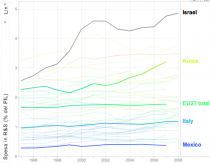
Il balzo della Corea del Sud nella ricerca
The considerable investment in human and economic resources, in the area of higher education, is accompanied by high investments in scientific and technological resources. According to the latest data published by R&D Magazine , this year, Korea has invested in research and development (R & D) 42.9 billion dollars, which places it in fifth place overall in the world. Ahead of France and Great Britain. By way of comparison, Italy - which has both a higher population and a higher GDP - has invested 18.7 billion dollars, much less than half the Korean investment.
Notes
Researchers Per thousand employed, full-time equivalent
1 The data for Germany cover unified Germany from 1991 and western Germany only until 1990.
2 Series for Japan adjusted until 1995.
3 In Korea, prior to 2007, social sciences and humanities are excluded from the R&D data.
4 Until 2007, data for Sweden were for university graduates and not researchers. Until 2005, R&D data excluded R&D activities of State and local governments; SMEs were not fully covered, and prior to 1993 the surveys in the Business Enterprise, Government and Private Non-Profit sectors excluded R&D in the social sciences and humanities.
5 For the United Kingdom, total researchers from 1999 to 2004 is an OECD estimate.6 For the United States, the total researchers figure for 2000 to 2005 is an OECD estimate, and data from 1985 exclude military personnel.7 Before 2000, data for the business sector in China covered large and medium-sized enterprises only, hence the R&D data were underestimated.8 Due to the lack of a comprehensive business register in South Africa, R&D data may be underestimated by 10% to 15%.
Gross domestic expenditure on R&D As a percentage of GDP
1 The data for Germany cover unified Germany from 1991 and western Germany only until 1990.
2 Series for Japan adjusted until 1995.
3 In Korea, prior to 2007, social sciences and humanities are excluded from the R&D data.
4 For the Slovak Republic, data before 1994 refer to the Research and Development Base (RDB) and cover the whole activity of institutions and not only R&D. Defense R&D was totally excluded until 1997 and only partially included thereafter.
5 Until 2005, R&D data for Sweden excluded R&D activities of State and local governments; SMEs were not fully covered, and prior to 1993 the surveys in the Business Enterprise, Government and Private Non-Profit sectors excluded R&D in the social sciences and humanities.
6 For the United States, capital expenditure is not covered and R&D conducted by state and local governments is excluded.
7 For Brazil, data for the business enterprise sector are collected through innovation surveys with very low response rates and are likely to be underestimated. Data for the government sector and the higher education sector are estimated using budgetary information and are probably underestimated as well.
8 Before 2000, data for the business sector in China covered large and medium-sized enterprises only, hence the R&D data were underestimated.
9 The higher education sector and the small-scale industry sector of India are only partially covered. Data for 2006-7 and 2007-08 were estimated by applying sector-wise growth rates for the period 2001-02 to 2005-06.
10 Defense excluded. The statistical data for Israel are supplied by and under the responsibility of the relevant Israeli authorities. The use of such data by the OECD is without prejudice to the status of the Golan Heights, East Jerusalem and Israeli settlements in the West Bank under the terms of international law.
11 Due to the lack of a comprehensive business register in South Africa, R&D expenditure may be underestimated by 10% to 15%.


